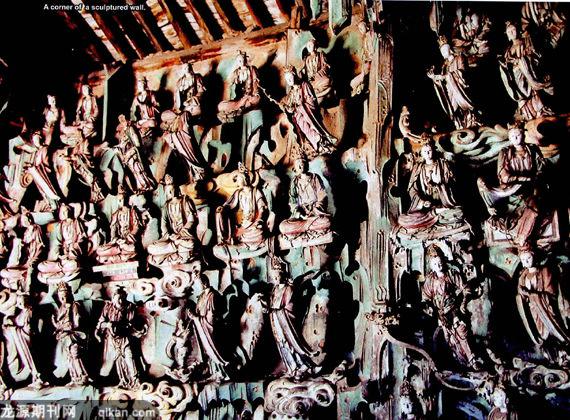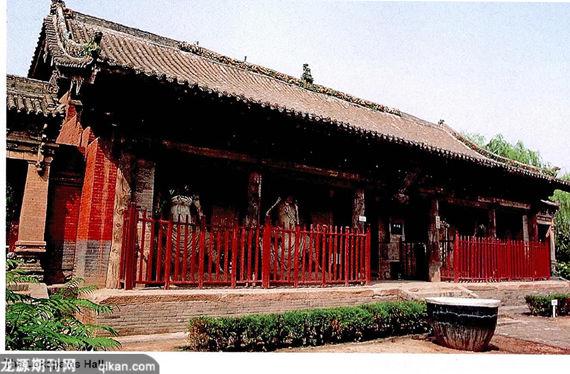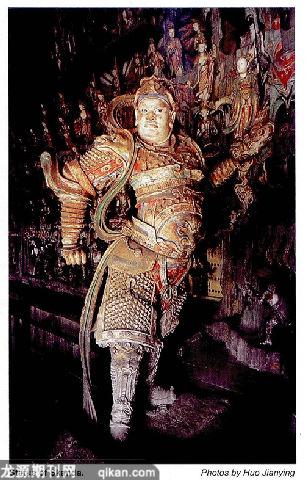World Cultural Heritage Site:Shuanglin Temple
2008-06-25staffreporterHUOJIANYING
staff reporter HUO JIANYING
IAOTOU is an ancient village in Pingyao, Shanxi Province, that is home to both men and gods. Its 2,000 villagers live in a walled compound accessed by four gates, while more than 2,000 deities and immortals occupy the Shuanglin Temple, located in the village center. Having survived 1,000 years of warfare and chaos together, the villagers and deities now live in peace and welcome a growingnumber of tourists and visitors.
History
Qiaotou Village is the site of ancient Zhongdu, a beautiful city that historical records describe as having been a bevy of economic and commercial activity amidst its many magnificent buildings, including an “awe-inspiring seven-story building.” Unfortunately, Zhongdu was destroyed by fire, but the cornerstones of the seven-story building can still be seen today. Their size – one meter across – testifies to the structures magnificence.

In ancient times, the Shuanglin Temple was named Zhongdu Temple. An inscribed stone stele, which still stands in the courtyard today, notes that it was renovated in the “second year of the Wuping Reign” (571) of the Northern Qi Dynasty, making the temple at least 1,400 years old. The renaming occurred during the Song Dynasty (960-1279).
The Shuanglin Temple was highly esteemed throughout succeeding dynasties. It was frequented by Buddhist pilgrims, and maintained and renovated by Buddhist patrons. Its current architecture and artifacts date largely to the Ming (1368-1644) and Qing (1644-1911) dynasties.
The temple was built on a three-meter-tall rammed earth terrace and composed of three courtyards with more than 10 halls. Within its 15,000 square meters are, among other treasures, Tang Dynasty (618-907) Chinese scholar-trees, a Song Dynasty inscribed stele, a Ming Dynasty bronze bell, and a large number of painted sculptures from the Ming and Qingdynasties.
Deified Women
I first visited the temple two decades ago, when it was little known to the outside world. The compound was undisturbed, though the gate was wide open. There was not a soul in sight, but the courtyard was very clean. The halls and sculptures looked dilapidated, and sparrows were nesting in the roof. A life-size sculpture was clad in a raincoat, the same kind worn by the villagers, probably to protect it from the water dripping from a leaky ceiling.
In the northeast corner of the temple I found a small “Hall of Fidelity and Chastity.” Inside were two statues, one of a young woman lying on a bed, her eyes closed, and one of an old lady, bony and wasted, sitting by her side. The villagers called the young woman “Sleeping Aunty,” and the old lady “Medical Granny.”
They were said to represent two sisters in-law from a well-off village family. To help her sister-in-law navigate the family through a difficult period, the young woman had remained unmarried and retained her chastity. Later, she fell ill and was bedridden for many years. Her sister-in-law, despite being much older, attended to her day and night. When the younger in-law breathed her last, the older woman also died of exhaustion and grief. Their mutual devotion and fidelity was deeply moving, and their last moment was eternalized in this hall of the Shuanglin Temple.
The locals observe the eighth day of the fourth lunar month as the birthday of Sakyamuni, or Gautama Buddha. In the past, the day was a ceremonial event for the villagers and the temple. It was also the day for the annual Shuanglin Temple Fair, when villagers and vendors from surrounding areas came to trade and burn joss sticks.
It was said that one year a handicapped vagrant covered in rags stopped at a bamboo curtain stall. The kind-hearted owner did not drive him away and offered him food and drink. After the meal, the vagrant fell asleep on a stack of bamboo curtains. Afraid of waking him, the vendor stopped hawking his wares until the man awoke and left. Then, a fragrant smell wafted from the bamboo curtains he had slept on, and the image of Avalokitesvara, the Goddess of Mercy, crossing the sea appeared on them. In no time, the vendors bamboo curtains were bought up, and the story quickly spread. The temple fair has been a major event in the area ever since.

Transformation of
Avalokitesvara
The Shuanglin Temples great achievements are represented by its painted sculptures, mostly from the Yuan, Ming and Qing dynasties (1271-1911). There are 2,052 of them, ranging from 30 centimeters tall to more than three meters, and more than 1,500 of them are still in good condition.
Buddhism flourished during the Ming Dynasty, when a great deal of money and manpower were spent on building temples and erecting Buddhist statues. Related crafts also reached their zenith. The Shuanglin Temple painted sculptures carried forward the artistic achievements of the Tang and Song dynasties and were masterpieces of Ming Dynasty painted sculpture.
Following its introduction from India into China in the first century, Buddhism gradually mingled and integrated with Chinese culture and philosophy, developing into one of the three dominant ideological systems – Confucianism, Buddhism and Taoism. During the course of its development, many elements of the alien religion were localized, and a typical example was the transformation of Avalokitesvara, or Guanyin.
Avalokitesvara was originally a prince, and was represented as a male figure when he first came to China in the third century. He remained that way until the sixth century, as testified to by the Dunhuang murals and sculptures up to that period. In the seventh century, however, Tang Dynasty grotto art began depicting Avalokitesvara in murals and sculptures as female.
Dunhuang was on the Old Silk Road, where natural conditions were harsh and bandits roamed freely. A female Goddess of Mercy, some scholars believe, served to reassure those who traveled the lawless wilderness.
Guanyin statues of the Tang Dynasty are characterized by the traits of feminine beauty of that period – an S-stance, a plump figure and gentle expression, a pretty complexion and elegant clothing. Some statues are even adorned with hairstyles in the Tang fashion. Were it not for the lotus seats, they would be no different from Tang Dynasty beauties depicted in the artwork of the period. It was an image of the elegance and benevolence of Guanyin which was widely embraced by later generations.
Exquisite Guanyin
Statues
The Shuanglin Temple stands out among the numerous Buddhist temples around the country in terms of the number and workmanship of its Guanyin statues. The best known are Guanyin Crossing the Sea, Guanyin at Leisure and Thousand-Armed Guanyin.
The Shuanglin Guanyin statues look more like human beings than deities. Guanyin at Leisure enshrined in the Thousand-Buddha Hall is representative of this temporal approach to Guanyin sculpture. When stepping into the hall, one may be surprised at first glance to discover a graceful lady, rather than a sacred Buddha, sitting in a relaxed manner on the shrine, her right leg folded up toward her waist and resting on the seat, her left leg dangling free, her arms and feet bare, and her hair wound up high on top of her head. This attitude was a breakthrough from stereotypical Buddhist statues, either standing or sitting in meditation.
Guanyin Crossing the Sea is behind the screen wall at the back of the Sakyamuni statue, in the main hall facing the back door. It can be seen clearly from the courtyard behind the main hall. Guanyin sits on a red lotus seat, one leg folded on the seat as it rides the turbulent waves. Around her are numerous attendant deities, all standing on the waves. The flying scarf around her body suggests the speed of their movement across the sea.

The Bodhisattva Hall is in essence a gathering place for deities in the Shuanglin Temple, housing as it does nearly 500 Buddhist statues. The main statue is Thousand-Armed Guanyin, one of the six transformations of Guanyin. It is a stereotypical Guanyin image, sitting legs folded on the lotus seat and smiling the same graceful and benevolent smile.
She holds the sun and moon in her 26 arms – indicating that she keeps a constant eye on the temporal world – and a wide variety of other articles, such as ritual utensils, objects of good omen for people of virtue, and weapons against demons and evil people. The 26 arms extend from the body, each an integral part of it, to form an impressive and wonderful image of Guanyin. The statue is still in a good condition and its colors still bright, particularly the rouge painted on her lips 500 years ago.
Expressive Guardian
Warriors
While Bodhisattva statues represent feminine beauty, lokapalas and other guardian deities exemplify masculinity at the Shuanglin Temple. The Lokapalas Hall is the first hall on the central axis of the temple complex inside its entrance. The four guardian warriors, each about three meters tall, stand abreast in the portico of the hall. They serve as the Buddhas bodyguards and are also responsible for guarding and protecting Buddhist temples.
Usually, these heavenly guardians are represented as ferocious and intimidating, but at the Shuanglin Temple their might and inviolability emanate from their masculine physique and stance. Each of the four guardians stands in his own attitude, ready for action at the first sign of danger. Their expressions vary and their eyes gaze in different directions, so that visitors meet their stare whichever way they look as they step through the entrance.
The statue of Skanda at the temple is acknowledged as a masterpiece of its kind. Skanda is represented leading the 32 guardian warriors under Lokapalas. Skanda stands out among the many heavenly warriors because he courageously fought and defeated demons, retrieving the Buddhas remains after his nirvana, which the demons had stolen.

Though most Buddhist temples enshrine Skanda, he usually stands inconspicuously in a minor position. The statue of Skanda at Shuanglin is next to Guanyins lotus seat. He is lifelike in stature, attire and expression. His stout body stands in an S-shape, the center of gravity on his left foot and his head and upper body stretching as far to the right as possible. In this way, the sculptor masterfully created the illusion of motion through static art.
The Shuanglin Temple has many such masterpieces, and it was the temple and its masterpiece sculptures that helped contribute to the ancient city of Pingyaos listing as a UNESCO World Cultural Heritage site in 1997.
Their expressions vary and their eyes gaze in different directions, so that visitors meet their stare whichever way they look as they step through the entrance.
The Shuanglin Temple stands out among the
numerous Buddhist temples around the country in terms of the number and workmanship of its
Guanyin statues.
